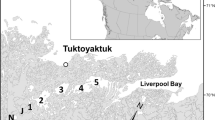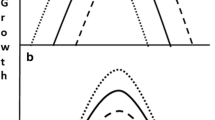Abstract
Many organisms occupy considerably different environments during individual's lifespan. We are interested in how the phenotypic characteristics that are favourable in the earlier environment predict fitness in the later environment. High predictability of fitness between the two consecutive environments suggests that the either the same traits are favored in both environments, or that the favourable traits are genetically correlated. In this study, we ask how similarity of consecutive foraging environments affects the phenotypic correlation of juvenile brown trout growth rate. More specifically, we used a genetically narrow stock of hatchery-bred fish to contrast individual growth rates between high and low density hatchery environments, and thereafter between hatchery and natural lake environment. As expected, growth rate was highly dependent on the environment, and the fish showed considerable phenotypic plasticity. Furthermore, we found a strong positive correlation in growth rate between similar foraging environments, for example, between high and low density hatchery stocks, and between hatchery and a lake with small fish as main prey. However, hatchery growth did not predict growth rate in lakes where fish had to forage on bottom-dwelling invertebrates. Our results suggest that when the consecutive environments differed dramatically with respect to traits that fish use for foraging, relative performance of individual fish changed, earlier performance not being an accurate predictor of performance in the new environment. In this case, fitness of the fish was determined by an environment-specific set of traits that were not the same between the two consecutive environments. The result indicates that assessment of individual performance may be highly environment specific in trout.
Similar content being viewed by others
References
Bergman, P.K., Haw, F., Blankenship, H.L. and Bucley, R.M. (1992) Perspectives on design, use, and misuse of fish tags. Fisheries 17, 20–25.
Blouin, M.S. (1992) Genetic correlations among morphometric traits and rates of growth and differentiation in the green tree frog, Hyla cinerea. Evolution 46, 735–744.
Bradshaw, A.D. (1965) Evolutionary significance of phenotypic plasticity. Advances in genetics 13, 115–155.
Carter, C.G., Houlihan, D.F. and Owen, S.F. (1998) Protein synthesis, nitrogen excretion and long–term growth of juvenile Pleuronectes flesus. J. Fish Biol. 53, 272–284.
Elliott, J.M. (1994) Quantitative Ecology and the Brown Trout. Oxford University Press, Oxford.
Elliott, J.M., Hurley, M.A. and Fryer, R.J. (1995) A new, improved growth model for brown trout, Salmo trutta. Func. Ecol. 9, 290–298.
Gjerde, B. (1986) Growth and reproduction in fish and shellfish. Aquaculture 38, 37–55.
Grant, J.W.A. (1990) Aggressiveness and the foraging behaviour of young–of–the–year brook charr (Salvelinus fontinalis). Can. J. Fish. Aquat. Sci. 47, 915–920.
Haw, F., Bergman, P.K., Fralick, R.D., Bucley, R.M. and Blankenship H.L. (1990) Visible implanted fish tag. Am. Fish. Soc. Symp. 7, 311–315.
Hughes, N.F. and Dill, L.M. (1990) Position choise by drift–feeding salmonids: model and test for arctic crayling (Thymallus arcticus) in subarctic mountain streams, interior Alaska. Can. J. Fish. Aquat. Sci. 47, 2039–2048.
Hutchings, J.A. and Morris, D.W. (1986) The influence of phylogeny, size and behaviour on patterns of covariation in salmonid life histories. Oikos 45, 118–124.
Hutchings, J.A. (1993) Adaptive life histories effected by age–specific survival and growth rate. Ecology 74, 673–684.
Hutchings, J.A. (1996) Adaptive phenotypic plasticity in brook trout, Salvelinus fontinalis, life histories. Ecoscience 3, 25–32.
Huusko, A., van der Meer, O. and Koljonen, M.–L. (1990) Life history patterns and genetic differences in brown trout (Salmo trutta L.) in the Koutajoki River system. Pol. Arch. Hydrobiol. 37, 63–77.
Huusko, A. and Korhonen, P. (1993) Population densities of young stages of the brown trout (Salmo trutta L.) in the Oulankajoki river system. Oulanka Reports 12, 125–127.
Hyslop, E.J. (1980) Stomach contents analysis–a review of methods and their application. J. Fish Biol. 17, 411–429.
Jobling, M. and Reinsnes, T.G. (1986) Physiological and social constrains on growth of Arctic charr Salvelinus alpinus L.: an investigation of factors leading to stunting. J. Fish Biol. 28, 379–384.
Jobling, M. and Baardvik, B.M. (1994) The influence of environmental manipulations on inter–and intra–individual in food aquisation and growth performance of Arctic charr, Salvelinus alpinus. J. Fish Biol. 44, 1069–1087.
Kadri, S., Huntingford, F.A., Metcalfe, N.B. and Thorpe, J.E. (1996) Social interactions and the distribution of food among one–sea–winter Atlantic salmon (Salmo salar) in a sea–cage. Aquaculture 139, 1–10.
Kohane, M.J. and Parsons, P.A. (1988) Domestication: evolutionary changes under stress. In M.K. Hecht and B. Wallace (eds) Evolutionary biology 23. Hardbound, pp. 31–48.
Loeschcke, V. and Krebs, R.A. (1996) Selection for heat–shock resistance in larval and adult Drosophila buzzatii: comparing direct and indirect responses on viability and development. Evolution 50, 2354–2359.
Martel, G. (1996) Growth rate and influence of predation risk on territoriality in juvenile coho salmon (Oncorhynchus kisutch). Can. J. Fish. Aquat. Sci. 53, 660–669.
McCarthy, I.D., Carter, C.G. and Houlihan, D.F. (1992) The effect of feeding hierarchy on individual variability in daily feeding of rainbow trout, Oncorhynchus mykiss (Walbaum). J. Fish Biol. 28, 525–532.
Merrick, G.W., Hershey, A.E. and McDonald, M.E. (1992) Salmonid diet and the size, distribu tion, and density of benthic invertebrates in an arctic lake. Hydrobiologia 240, 225–233.
Myers, R.A., Hutchings, J.A. and Gibson, R.J. (1986) Variation in male parr maturation within and among populations of Atlantic salmon, Salmo salar. Can. J. Fish. Aquat. Sci. 43, 1242–1248.
Mäki–Petäys, A., Muotka, T., Huusko, A., Tikkanen, P. and Kreivi, P. (1997) Seasonal changes in habitat use and preference by juvenile brown trout, Salmo trutta, in a northern boreal river. Can. J. Fish. Aquat. Sci. 54, 520–530.
Niva, T. (1995) Retention of visible implant tags by juvenile brown trout. J. Fish Biol. 46, 997–1002.
Niva, T. (1999) Relations between diet, growth, visceral fat content and yield of stocked brown trout in three small lakes in northern Finland. Ann. Zool. Fenn. 36, 103–120.
Niva, T. and Julkunen, M. (1998) Effect of population fluctuation of vendace (Coregonus albula) on the diet and growth of stocked brown trout (Salmo trutta). Arch. Hydrobiol. Spec. Issues Advanc. Limnol. 50, 295–303.
O'Gorman, R., Bergstedt, R.A. and Eckert, T.H. (1987) Prey fish dynamics and salmonine predator growth in Lake Ontario, 1978–84. Can. J. Fish. Aquat. Sci. 44, 390–403.
Olla, B.L., Davis, M.W., Ryer, C.H. (1994) Behavioural deficits in hatchery–reared fish: potential effects on survival following release. Aquacul. Fish. Mgmt. 25, 19–34.
Price, E.O. (1984) Behavioral aspects of animal domestication. Q. Rev. Biol. 59, 1–32.
Rungruangsak–Torrissen, K., Carter, C.G., Sundby, A., Berg, A. and Houlihan, D.F. (1999) Maintenance ration, protein synthesis capacity, plasma insulin and growth of Atlantic salmon (Salmo salar L.) with genetically different trypsin isozymes. Fish Physiol. Biochem. 21, 223–233.
Roff, D.A. (1984) The evolution of life history parameters in teleosts. Can. J. Fish. Aquat. Sci. 41, 989–1000.
Roff, D.A. (1992) The Evolution of Life Histories; Theory and Analysis. Chapman & Hall, New York.
Schilichting, C.D. and Pigliucci, M. (1998) Phenotypic Evolution: A Reaction Norm Perspective. Sinauer Associates, Inc., Sunderland, Massachusetts, USA.
Stearns, S.C., De Jong, G. and Newman, B. (1991) The effects of phenotypic plasticity on genetic correlations. Trends Ecol. Evol. 6, 122–126.
Stearns, S.C. (1992) The Evolution of Life Histories. Oxford University Press, Oxford.
Thorpe, J.E., Miles, M.S. and Keay, D.S. (1984) Developmental rate, fecundity and egg size in Atlantic salmon, Salmo salar L. Aquaculture 43, 289–305.
Wang, L., Zimmer, K., Diedrich, P. and Williams, S. (1996) The two–story rainbow trout fishery and its effect on the zooplankton community in a Minnesota lake. J. Freshwat. Ecol. 11, 67–80.
Via, S. and Lande, R. (1985) Genotype–environment interaction and the evolution of phenotypic plasticity. Evolution 39, 505–522.
Via, S., Gomulkiewicz, R., Dejong, G., Scheiner, S.M., Schlichting, C.D. and Vantienderen, P.H. (1995) Adaptive phenotypic plasticity: consensus and controversy. Trends Ecol. Evol. 10, 212–217.
Author information
Authors and Affiliations
Corresponding author
Rights and permissions
About this article
Cite this article
Niva, T., Jokela, J. Phenotypic Correlation of Juvenile Growth Rate between Different Consecutive foraging Environments in a Salmonid fish: A Field Experiment. Evolutionary Ecology 14, 111–126 (2000). https://doi.org/10.1023/A:1011066912342
Issue Date:
DOI: https://doi.org/10.1023/A:1011066912342




